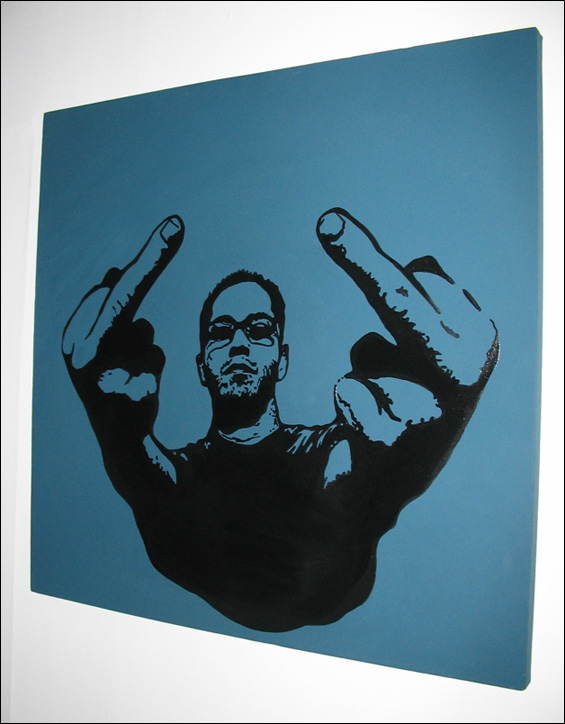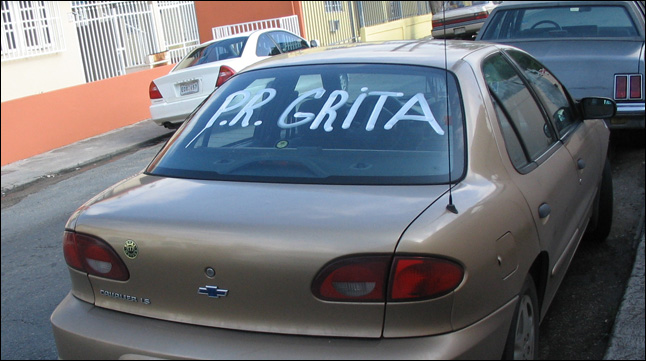
Omar’s Double Birdie


Our visit to the gallery =DESTO la otra noche was fruitful, at least for us it was, because we got to peruse new work by the three honorable =Destoños: squiggly little pencil-drawn slogans by Jason Mena, made in collaboration with his six-year-old primo, Bryan, colorful inscriptions on plastic by Raquel Quijano which pose curious architectonic- geometric equations, and several paintings by Omar Obdulio Peña Forty, including the very blue beauty above (“Two Fingers,” 30 x 30 inches, acrylic and enamel on canvas, 2006).
One of Omar’s paintings bears a slogan that’s much in evidence these days, painted on walls, utility poles, and car windows everywhere, “Puerto Rico Grita.” I asked the =Destoños to tell me about it. Not that any fool doesn’t know that gritando is shouting, but for over a week now the island has been suffering a paroxysm of more than the usual governmental idiotez y avaricia, with the governor and the legislature, of bitterly opposing political parties, ruthlessly duking it out over whether or not to pay off a gargantuan budget deficit that has been building for generations of heedlessly spendthrift administrations. It’s an enormously complicated and ugly fight, truly worthy of a banana republic, but the result has been that 95,000 government employees are suddenly out of work, contractors’ bills are going unpaid, fifteen of the island’s municipalities—yesterday’s count—have ceased operations altogether, schools everywhere have shut down before the end of the term, and the island’s credit rating is going immediately to shit. “People are sick of it,” Jason said, to explain why so many people want to cry out.
We’re talking about a degree of real human suffering here, working people suddenly on the dole and students whose academic trajectories are cut short, on a massive scale. A general strike was being called for today, which would certainly add a great deal to the anxiety and rage that has been building among ordinary folk, though little, probably, toward a solution to the crisis. In this light, Omar’s lovely, emphatic fuck-yous are just right.

So I was struck by the coincidence of the following quote from Miami gallery owner Fred Snitzer, which made its way into a couple of Miami blogs, Critical Miami and thenextfewhours.com. Snitzer is one of the most enduring, and arguably one of the most successful, art dealers in the engorged, delirious Miami art scene of 2006. In a recent article about the art business in The Miami Herald, Snitzer is understandably testy about the implication that, as a member of the Art Basel Miami Beach gallery selection committee, he is responsible for which galleries get to be exhibitors in the gilded halls and which do not. He notes that he is only one of a dozen committee members, disparages the programs of those whose did not make it, and says, “I'm doing the exact same thing I was doing 29 years ago—showing the best work I can and selling as much of it as I can. That’s it.” Almost gratuitously, he adds, “All the artists that are mad at me because I won't represent them? Tough shit. It's my dime . . . ” Snitzer may have very good reason to flip Miami a double-barreled bird because . . . well, really, what can explain it?
There was a period, long before the art world worked itself into a froth about Miami, when Snitzer was just one more hard-working gallery owner in a town that was remarkable, astonishing really, for its provinciality and stinginess towards the very good local art scene and the people who had genuine faith in it. Before he owned a gallery, Snitzer was an artist, and the stories he told me about this period make it sound like great dada fun. I heard, in snatches from him and in noisy outbursts from several of the artists involved, that he’d spent a lot of time in the early- and mid-1990s trying to represent some of that often brilliant but deeply troubled crowd, the 80s generation Cuban artists who landed in south Florida after they fled the island. Only a couple of them, most notably José Bedia, had the sense to work with Snitzer over the long haul, the rest rewarding his willingness with headaches and abundant bad-mouthing. When I arrived in the city in 2000, his program struck me as one of the most interesting and steady among the city’s tiny cadre of serious galleries, featuring an admirable mix of hard-working known quantities who would probably labor forever in the shadows of their sufficient but not easily marketed talents, and promising newcomers who had more ready attitude than aptitude, some of them fresh out of the New World School of the Arts where Snitzer teaches. He had a cash cow or two to keep him afloat, but he worked hard to maintain the intensity and vitality of what he was up to. And this was the best part: he was certainly up to something besides sales.
You can’t say the passage of time made Snitzer any kinder or gentler. If you aren’t his close friend or one of his artists or someone who buys a lot of high-ticket items from him, he appears to have settled into the remote to icy range on the amiability scale, even at his own very warm and jam-packed openings. And who can blame him? In addition to the long years leading up to Art Basel’s descent on Miami, it took several exhausting and otherwise aggravating stints at the fair—we’re talking about three or four years of intensive effort—before the local scene’s exertions reached anything resembling a payoff. But as an art dealer, he has never slackened in his commitment to his program.
So it appears that Fred Snitzer, in the midst of a boom time he helped to create, has by all measures reached the top of his game. For anyone with a heartfelt interest in the folks that really matter in all this—the artists of Miami—the best thing about his success is that it seems he has never succumbed to purely commercial impulses and he remains committed to home-grown talent. He continues to mix the tried and true with new hotties, maintaining artists whose commercial appeal is obvious, like Gavin Perry, and the not so much so, like the wildly anti-market hodgepodgery of Gean Moreno, the prickly, even hellish nebulosities of Cooper, and the strangely beautiful but hardly living-room ready vampire tableaux of Beatriz Monteavaro. His program is not only strong but supple, ever ready for the vagaries of the quickly mutating scene.
That’s what makes the Fred Snitzer story, with its sneering man-boy imprecations in the midst of plenty, such a riddle. Is Snitzer really a happy-go-lucky guy, posing the ill-humored pose and dishing the nasty dish, all in ironic, mischievous fun? Is he misquoted and misunderstood? Or is his the face of Miami’s future, wearing its profound dissatisfaction with all that success in a rictus of bully defiance? There has always been some distasteful undercurrent in the interpersonal dynamics of the Miami art world, but it was mostly confined to the vast warehouses of the city’s lordly collecting class. You have to wonder if the scene is actually beginning to resemble the most tired clichés about money and power. Anyone convinced that their brave new art-fair driven world is bigger brighter faster better should keep an ear out for Fred.
Turn the page here to treat yourself to another roundup of cultural miscellany from coast to coast, as we visit a toney opening at Museo de Arte de Ponce, the new Antonio Martorell room at Hotel El Convento, and the festive and very loud precincts of a Calle 13 concert.